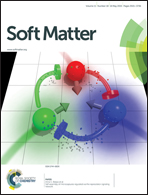Flow-induced 2D protein crystallization: characterization of the coupled interfacial and bulk flows
Abstract
Two-dimensional crystallization of the protein streptavidin, crystallizing below a biotinylated lipid film spread on a quiescent air–water interface is a well studied phenomenon. More recently, 2D crystallization induced by a shearing interfacial flow has been observed at film surface pressures significantly lower than those required in a quiescent system. Here, we quantify the interfacial and bulk flow associated with 2D protein crystallization through numerical modeling of the flow along with a Newtonian surface model. Experiments were conducted over a wide range of conditions resulting in a state diagram delineating the flow strength required to induce crystals for various surface pressures. Through measurements of the velocity profile at the air–water interface, we found that even in the cases where crystals are formed, the macroscopic flow at the interface is well described by the Newtonian model. However, the results show that even in the absence of any protein in the system, the viscous response of the biotinylated lipid film is complicated and strongly dependent on the strength of the flow. This observation suggests that the insoluble lipid film plays a key role in flow-induced 2D protein crystallization.


 Please wait while we load your content...
Please wait while we load your content...